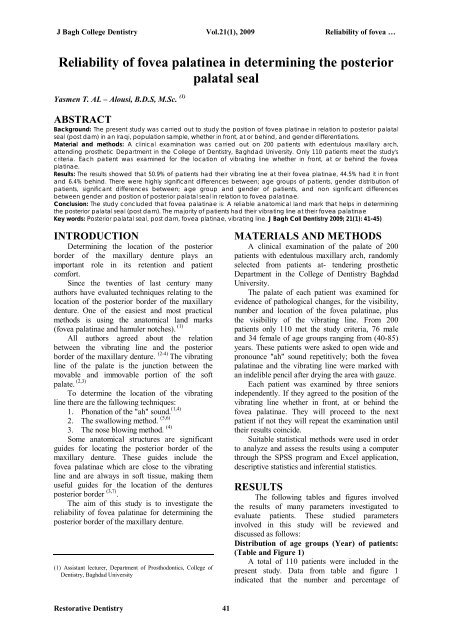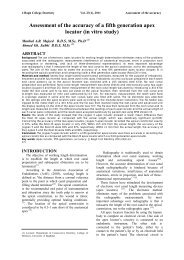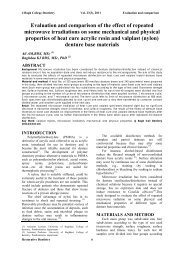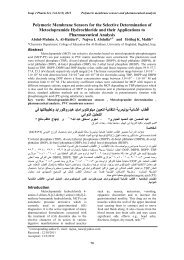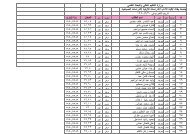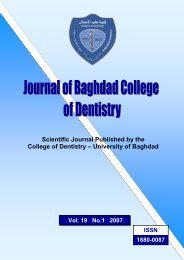Vol 21 No. 1
Vol 21 No. 1
Vol 21 No. 1
You also want an ePaper? Increase the reach of your titles
YUMPU automatically turns print PDFs into web optimized ePapers that Google loves.
J Bagh College Dentistry <strong>Vol</strong>.<strong>21</strong>(1), 2009 Reliability of fovea …<br />
Reliability of fovea palatinea in determining the posterior<br />
palatal seal<br />
Yasmen T. AL – Alousi, B.D.S, M.Sc. (1)<br />
ABSTRACT<br />
Background: The present study was carried out to study the position of fovea platinae in relation to posterior palatal<br />
seal (post dam) in an Iraqi, population sample, whether in front, at or behind, and gender differentiations.<br />
Material and methods: A clinical examination was carried out on 200 patients with edentulous maxillary arch,<br />
attending prosthetic Department in the College of Dentistry, Baghdad University. Only 110 patients meet the study's<br />
criteria. Each patient was examined for the location of vibrating line whether in front, at or behind the fovea<br />
platinae.<br />
Results: The results showed that 50.9% of patients had their vibrating line at their fovea platinae, 44.5% had it in front<br />
and 6.4% behind. There were highly significant differences between; age groups of patients, gender distribution of<br />
patients, significant differences between; age group and gender of patients, and non significant differences<br />
between gender and position of posterior palatal seal in relation to fovea palatinae.<br />
Conclusion: The study concluded that fovea palatinae is: A reliable anatomical land mark that helps in determining<br />
the posterior palatal seal (post dam). The majority of patients had their vibrating line at their fovea palatinae<br />
Key words: Posterior palatal seal, post dam, fovea platinae, vibrating line. J Bagh Coll Dentistry 2009; <strong>21</strong>(1): 41-45)<br />
INTRODUCTION<br />
Determining the location of the posterior<br />
border of the maxillary denture plays an<br />
important role in its retention and patient<br />
comfort.<br />
Since the twenties of last century many<br />
authors have evaluated techniques relating to the<br />
location of the posterior border of the maxillary<br />
denture. One of the easiest and most practical<br />
methods is using the anatomical land marks<br />
(fovea palatinae and hamuler notches). (1)<br />
All authors agreed about the relation<br />
between the vibrating line and the posterior<br />
border of the maxillary denture. (2-4) The vibrating<br />
line of the palate is the junction between the<br />
movable and immovable portion of the soft<br />
palate. (2,3)<br />
To determine the location of the vibrating<br />
line there are the fallowing techniques:<br />
1. Phonation of the "ah" sound. (1,4)<br />
2. The swallowing method. (5,6)<br />
3. The nose blowing method. (4)<br />
Some anatomical structures are significant<br />
guides for locating the posterior border of the<br />
maxillary denture. These guides include the<br />
fovea palatinae which are close to the vibrating<br />
line and are always in soft tissue, making them<br />
useful guides for the location of the dentures<br />
posterior border (3,7) .<br />
The aim of this study is to investigate the<br />
reliability of fovea palatinae for determining the<br />
posterior border of the maxillary denture.<br />
(1) Assistant lecturer, Department of Prosthodontics, College of<br />
Dentistry, Baghdad University<br />
MATERIALS AND METHODS<br />
A clinical examination of the palate of 200<br />
patients with edentulous maxillary arch, randomly<br />
selected from patients at- tendering prosthetic<br />
Department in the College of Dentistry Baghdad<br />
University.<br />
The palate of each patient was examined for<br />
evidence of pathological changes, for the visibility,<br />
number and location of the fovea palatinae, plus<br />
the visibility of the vibrating line. From 200<br />
patients only 110 met the study criteria, 76 male<br />
and 34 female of age groups ranging from (40-85)<br />
years. These patients were asked to open wide and<br />
pronounce "ah" sound repetitively; both the fovea<br />
palatinae and the vibrating line were marked with<br />
an indelible pencil after drying the area with gauze.<br />
Each patient was examined by three seniors<br />
independently. If they agreed to the position of the<br />
vibrating line whether in front, at or behind the<br />
fovea palatinae. They will proceed to the next<br />
patient if not they will repeat the examination until<br />
their results coincide.<br />
Suitable statistical methods were used in order<br />
to analyze and assess the results using a computer<br />
through the SPSS program and Excel application,<br />
descriptive statistics and inferential statistics.<br />
RESULTS<br />
The following tables and figures involved<br />
the results of many parameters investigated to<br />
evaluate patients. These studied parameters<br />
involved in this study will be reviewed and<br />
discussed as follows:<br />
Distribution of age groups (Year) of patients:<br />
(Table and Figure 1)<br />
A total of 110 patients were included in the<br />
present study. Data from table and figure 1<br />
indicated that the number and percentage of<br />
Restorative Dentistry 41


